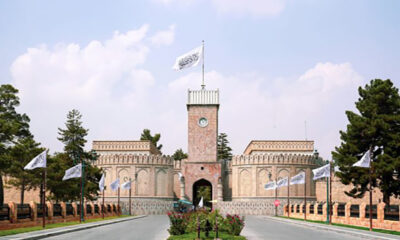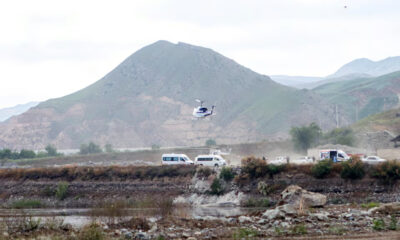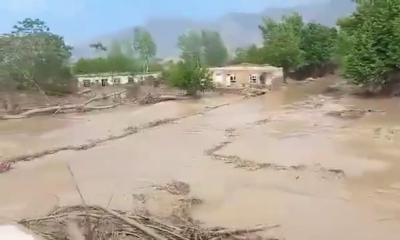Climate Change
Canada’s wildfires intensify, doubling evacuations to over 35,000

Forest fires in Canada’s western province of British Columbia intensified on Saturday, with the number of people under evacuation orders doubling from a day earlier, as authorities warned of difficult days ahead.
The province declared a state of emergency on Friday to access temporary authoritative powers to tackle fire-related risks, as out-of-control fires ripped through interior British Columbia, partially shutting some sections of a key highway between the Pacific coast and the rest of western Canada, and destroying many properties, Reuters reported.
“The current situation is grim,” Premier Daniel Eby told reporters on Saturday, saying some 35,000 people were under an evacuation order, and a further 30,000 were under an evacuation alert.
Eby said the province is in dire need of shelter for evacuees and firefighters and ordered a ban on non-essential travel to make more temporary accommodation available. Officials also urged residents to avoid operating drones in the fire zone, saying it could impede firefighting efforts.
The fire is centered around Kelowna, a city some 300 kilometers east of Vancouver, with a population of about 150,000.
Forest fires are not uncommon in Canada, but the spread of blazes and disruption underscore the severity of its worst wildfire season yet.
About 140,000 square km of land, roughly the size of New York state, has already burned, and government officials project the fire season could stretch into autumn due to widespread drought-like conditions in Canada.
B.C. had experienced strong winds and dry lightning in the past few days due to a cold mass of air interacting with hot air built-up in the sultry summer. That intensified existing forest fires and ignited new ones.
“We are still in some critically dry conditions, and are still expecting difficult days ahead,” said Jerrad Schroeder, deputy fire center manager at the Kamloops Fire Centre.
Prime Minister Justin Trudeau convened a meeting of key ministers and senior officials on Saturday to discuss wildfires. The Incident Response Group, which met for the second time this week, agreed to make “additional resources available” to both British Columbia and the Northwest Territories (NWT).
The TransCanada highway was closed near Chase, around 400 km northeast of Vancouver, and between Hope, 150 km east of Vancouver, and the village of Lytton.
The highway is the main east-west artery used by thousands of motorists and truckers heading to Vancouver, the country’s busiest port.
Kip Lumquist, who works at a gift shop in Craigellachie, British Columbia, a tourist spot on the highway, said she saw a lot of devastation over the past week.
“It was crazy, we couldn’t see the hills, the mountains, the trees, anything, probably (for) two and a half days,” said Lumquist. “I drive a white vehicle, and when I walked out to get in my car… it’s just black… It’s devastating to the community.”
By Friday, the fire in southern B.C. had grown more than a hundredfold in 24 hours and forced more than 2,400 properties to be evacuated.
The flames have destroyed several structures in West Kelowna and authorities have been warning that the province could potentially face the worst couple of days of the fire season this year.
B.C. currently accounts for over a third of Canada’s 1,062 active fires.
Climate Change
Hot weather poses new risk after deadly Houston storms

As the Houston area works to clean up and restore power to hundreds of thousands after deadly storms left at least seven people dead, it will do so amid a smog warning and scorching temperatures that could pose health risks.
National Weather Service meteorologist Marc Chenard said on Saturday that highs of around 32.2 C were expected through the start of the coming week, with heat indexes likely approaching 38 C by midweek, Associated Press reported.
“We expect the impact of the heat to gradually increase … we will start to see that heat risk increase Tuesday into Wednesday through Friday,” Chenard said.
The heat index is what the temperature feels like to the human body when humidity is combined with the air temperature, according to the weather service.
Heavy rainfall was possible in eastern Louisiana and central Alabama on Saturday, and parts of Louisiana were also at risk for flooding.
The Houston Health Department said it would distribute 400 free portable air conditioners to area seniors, people with disabilities and caregivers of disabled children to contend with the heat.
The widespread destruction of Thursday’s storms brought much of Houston to a standstill, AP reported.
Thunderstorms and hurricane-force winds tore through the city — decimating the facade of one brick building and leaving trees, debris and shattered glass on the streets. A tornado also touched down near the northwest Houston suburb of Cypress.
More than a half-million homes and businesses in Texas remained without electricity by midday Saturday, according to PowerOutage.us.
Another 21,000 customers were also without power in Louisiana, where strong winds and a suspected tornado hit.
CenterPoint Energy said power restoration could take several days or longer in some areas.
Harris County Judge Lina Hidalgo and Whitmire both signed disaster declarations, paving the way for state and federal storm recovery assistance.
A separate disaster declaration from President Joe Biden makes federal funding available to people in seven Texas counties — including Harris — that have been affected by severe storms, straight-line winds, tornadoes and flooding since April 26.
Climate Change
Summer 2023 was the hottest in 2,000 years, study says

The intense northern hemisphere summer heat that drove wildfires across the Mediterranean, buckled roads in Texas and strained power grids in China last year made it not just the warmest summer on record – but the warmest in some 2,000 years, new research suggests.
The stark finding comes from one of two new studies released on Tuesday, as both global temperatures and climate-warming emissions continue to climb, Reuters reported.
Scientists had quickly declared last year’s June to August period as the warmest since record-keeping began in the 1940s.
New work published in the journal Nature suggests the 2023 heat eclipsed temperatures over a far longer timeline – a finding established by looking at meteorological records dating to the mid-1800s and temperature data based on the analysis of tree rings across nine northern sites.
“When you look at the long sweep of history, you can see just how dramatic recent global warming is,” said study co-author Jan Esper, a climate scientist at Johannes Gutenberg University in Germany.
Last year’s summer season temperatures on lands between 30 and 90 degrees north latitude reached 2.07 degrees Celsius higher than pre-industrial averages, the study said.
Based on tree ring data, the summer months in 2023 were on average 2.2 C warmer than the estimated average temperature across the years 1 to 1890.
The finding was not entirely a surprise. By January, scientists with the European Union’s Copernicus Climate Change Service were saying the year of 2023 was “very likely” to have been the warmest in some 100,000 years.
However, proving such a long record is unlikely, Esper said. Heatwaves are already taking a toll on people’s health, with more than 150,000 deaths in 43 countries linked to heatwaves for each year between 1990 and 2019, according to the details of a second study published on Tuesday in the journal PLOS Medicine.
That would account for about 1% of global deaths – roughly the same toll taken by the global COVID-19 pandemic, Reuters reported.
More than half of those heatwave-related excess deaths occurred in populous Asia.
Climate Change
Afghanistan a victim of climate change, says Muttaqi

The Acting Minister of Foreign Affairs, Amir Khan Muttaqi, met with Edem Wosornu, UNOCHA Director of Operations and Advocacy on Monday in Kabul and said although Afghanistan plays no role in the “destruction of the climate”, the country continues to suffer from this phenomenon.
Muttaqi appealed to countries contributing to the climate change problem to act responsibly as they are not doing anything in terms of compensating countries suffering the effects of climate change.
This comes just days after heavy rains claimed the lives of over 300 people in northern Afghanistan as flash floods hit the area.
Muttaqi meanwhile also said that Afghanistan should be allowed to participate at global climate change meetings and the country should have access to funding.
Wosornu in turn expressed her willingness to send UNOCHA teams to flood affected areas as soon as possible.
She also said they try to keep humanitarian needs and politics separate.
-

 World5 days ago
World5 days agoManhunt underway after gunmen ambush French prison van to free drug dealer
-

 World4 days ago
World4 days agoEU adds Russian media outlets to sanctions list despite Kremlin warning
-

 Latest News4 days ago
Latest News4 days agoTorkham crossing closes temporarily to travelers
-

 Sport4 days ago
Sport4 days agoSorkh Poshan Khafi and Sarsabz Yashlar win in ACL matches
-

 Business4 days ago
Business4 days agoAzizi meets with head of Tatarstan on sidelines of Kazan Forum
-

 Latest News4 days ago
Latest News4 days agoJapan pledges emergency aid to Afghanistan’s flood victims
-

 Latest News5 days ago
Latest News5 days agoMinistry of Defense confirms one dead, 12 injured in chopper crash in Ghor
-

 Latest News5 days ago
Latest News5 days agoIEA’s political deputy meets with Japanese ambassador
























